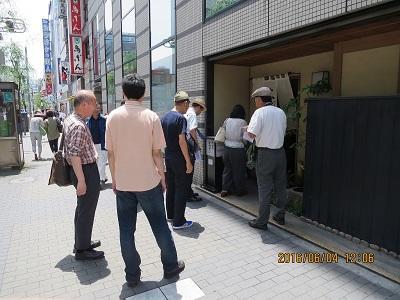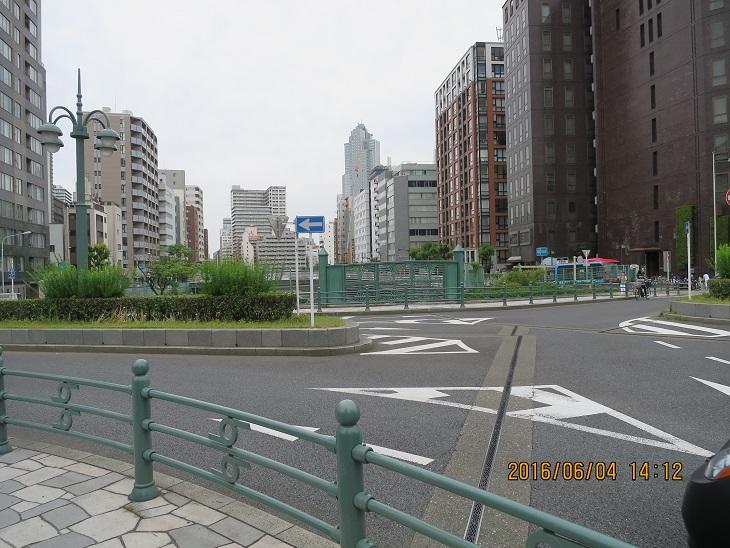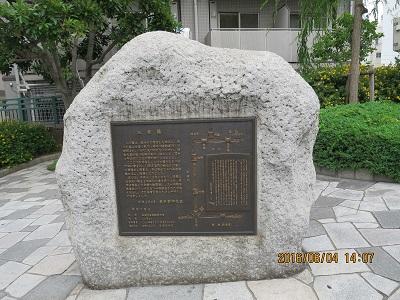List of Authors
>>About this blog
Recent blog post
|
[CAM]
June 23, 2016 18:00
When considering history and origin, what must never be done is to judge by "gochie", and you must not always lose the attitude of thinking at the beginning.
Mr. Yasaburo Ikeda said, "Osaka also has Nihonbashi and Kyobashi ... In the case of Osaka, it is a surprise that this is called Nipponbashi. In other words, in Edo, Nihonbashi was not called Nipponbashi, but Nihonbashi, I think it would be a proof that "Nihonbashi" was not originally (the name of Nihonbashi, Tokyo), but "Nihonbon." (56) is described.
Nihonbashi, Tokyo, which was replaced in 1618 (1618), was a wooden bridge with a length of about 67.8m and a width of 7.8m (page 118 of the Chuo-ku Monoshiri Encyclopedia), while Nihonbashi in Osaka was built on the Dotonbori River by Edo shogunate in 1619 (1619). It is a wooden bridge with a length of about 40m and a width of about 7m, and was the only official bridge in the Dotonbori River (Wikipedia). As Ikeda stated, in the Keicho era interview book, the size of the bridge that was replaced in 1618 is described, but there is no description of the size of the bridge before that (page 92 of "Nihonbashi Private Note"). This also makes a speculation that the previous one might have been quite poor.
Kogibashi is a bridge managed by the Shogunate and performs replacements and repairs at the expense of the Shogunate. In the case of Kogibashi, a bronze giboshi was attached. In the case of Edo, there were about 120 to 170 in the city, including 160 to 170 in addition to 4 and50 in the inside and outside of Edo Castle. However, according to a survey conducted in 1787 (1787), the number of public bridges in Osaka at that time was only 12. This can be said to indicate how large the creation of "Osaka, the capital of water" was due to the power of townspeople (Ryoichi Okamoto, "History of Osaka"; 60).
In this way, if one of the few public bridges in Osaka, which were built by the Shogunate in 1619 (one year after the rebuilding of the Tokyo Nihon Bridge), were called "Nipponbashi" from that time, It is highly probable that Tokyo's one was called "Nihonbashi" for a while from around the time (the 1603 theory is influential), it is quite persuasive Yasaburo above.
In the lyrics "Four Seasons of Rain" written by Ikeda, using the term "Nihonbashi" in the lyrics "Four Seasons of Rain" written by himself, "Osaka is Nipponbashi and Edo is Japanesebashi, Nihonbashi is a rational solution later, and in the old days it was Nihonbashi. Based on that, I tried it on purpose." (184)
[CAM]
June 23, 2016 16:00
When considering history and origin, what must never be done is to judge by "gochie", and you must not always lose the attitude of thinking at the beginning.
For example, regarding the name of the bridge in Nihonbashi, Monoshiri Encyclopedia says, "There are various theories about the origin of the bridge name, but in the magazine "Mifunai Remarks" edited by the Shogunate, "This bridge, in the center of Edo, Since the process of each country is determined here, it is said that Nihonbashi is named because it is named." This explanation says, "There are various theories about the origin of the bridge name," and of course it is not an error. However, "Remarks in Gofu" is a geographical magazine compiled by the Shogunate in 1829 (1829).
Nihonbashi is said to have been built by Ieyasu Tokugawa in 1603 (1603) (page 26 of Monoshiri Encyclopedia). At the time of this erection, only about 10 years have passed since Ieyasu was admitted to the prefecture in 1590 (1590), and the surrounding area should have been a desolate area full of reeds and thinness (" Monoshiri Encyclopedia") Page 116). After nearly 230 years, it would be too violent to use only the geography compiled by "Okami" as the basis for the origin of the bridge name.
Yasaburo Ikeda stated in "Nihonbashi Private Note" as "My (Japan) Bridge Nakihara Theory".
(1) Nihonbashi is a poor bridge that was originally built over the Nihonbashi River (although it was not named at that time), and it was called "Nihonbashi" from the appearance of the bridge.
(2) As the town of Edo was built, it was remodeled finely, and in the meantime, it came to be said that Nihonbashi was Nihonbashi.
(3) In order for everyone to receive the name "Nihonbashi", which I said to anyone, Nihonbashi became bustling, the neighborhood became a representative land of Japan, and became the center of the whole country, and the starting point of Gokaido The name of "Nihonbashi" became more and more appropriate as it became.
――I wonder if such a path could be considered. (48)
In recent books, as is the case with Monoshiri Encyclopedia, the part of (1) is short, and it seems that many describe the background of (2) and (3) from the beginning. However, as Ikeda says, not only the name of the bridge, but also the name of the place is simple, straightforward, and intuitive in the first place, considering that the name of the bridge is (1) I think we should think that there was a stage.
[CAM]
June 23, 2016 14:00
In a course, a lecturer told me that there was a sign of "Muromachi-dori" in a picture of the Echigo-ya Kyo main store in Kyoto ("Kyomoto pictorial map" from Mitsui Bunko's historical material), "Kyoto" There is also "Muromachi." This expression is strange. This is because the existence of Muromachi in Kyoto is (far) ahead, and Muromachi in Nihonbashi, Tokyo, should be (very) later naming.
You seem to get the word, but you are unconscious (even experts)? The mistake is that Osaka and Kyoto are advanced areas, and the late-developed areas, Edo, became able to compete with Kansai only after the late Edo period was quite late. Isn't it?
By the way, the origin of the place name of "Nihonbashimuro-cho" is described in the website of Chuo-ku "Origin of Place Name".
"There is a theory that it was followed by Muromachi in Kyoto and that there were many merchants, and that the storehouses (rooms) were lined up." According to Monoshiri Encyclopedia, "In 1931, Hikokichi Nakazawa's idea, he was chosen and named a happy name. "(173 pages) may not be possible.
However, at least the expression "Muromachi" in "Kyoto" would be strange.
[CAM]
June 11, 2016 16:00
It seems that Yukio Mishima matched Mrs. Yoko's wife "Ginza Hamasaku".
Inose Naoki's "Persona" states as follows.
>The matchmaking with Yoko Sugiyama was April 13, 1958. (Yuasa) Atsuko was present and had a meal at Hamasaku in Ginza. Then I invited him to the nightclub. While dancing, the steps did not flow easily, so I judged that there was almost no play gap. Mishima thanked Atsuko and sent Yoko to his home. Atsuko thought it was going to be decided when she told her to send it to her home. The next day, Mishima called Atsuko. "It's pretty good," he said.
Immediately after that, Wabunge was admitted to the University of Tokyo Hospital. On the eve of hospitalization, Mishima had a "last dinner" with Wabunge and Hamasaku. " (289)
(Here, the "last dinner" with my mother was diagnosed as having a life expectancy of four months. However, as a result of surgery, the tumor was not malignant.)
Regarding this matchmaking, Wikipedia "Yoko Hiraoka" stated as follows:
>On April 13, Yuasa took Yoko to meet Mishima at the German restaurant "Ketell" in Ginza, and then went to a night club in Aoyama after having dinner at "Hamasaku" with three people. When Mishima was dancing with Yoko, she found that Yoko wasn't out of play, and on the 14th of the following day, reported to Yuasa that she liked it, "Isn't it quite good?" Yoko's impression was also happy, saying, "It seemed to be somehow."
As I mentioned earlier, Mishima has been using Ginza Hamasaku frequently since then.
According to Takao Tokuoka's "The People of Goten" (Bunshun Bunko), Tokuoka last met Mr. Mishima was Hamasaku. In September 1970, just before Mishima died, Mr. Tokuoka was called by Mr. Mishima to Hamasaku, and at that time, Mr. Tokuoka seemed to make a mistake of delaying 40 minutes to the promised time.
"Even now, I'm ashamed of the failure at that time, and I've never revisited the store with fear of returning memories. I remember that "Kansai Kappo cuisine" appeared next to Omotedo, which I pulled out of breath, so I think it was Ginza's Hamasaku. The lower floor was a counter, and the second floor was a parlor. When I ran up the stairs and entered the room, Mishima was lying on the tatami mats. "(164).
John Nathan also said, "I met Mishima and Ginza's Hamasaku, and drank a lot of liquor at the Shiraki counter. Mishima was in a good mood. Of course, I did. Mishima thanked me for translation, and I said I was relieved to meet his expectations." (John Nathan, "Yukio Mishima - A Reputation", translated by Takehiko Noguchi, Shinchosha)
I met him at Hamasaku, a Japanese-style restaurant on the Ginza patronized by the literary establishment. We ate at the wooden counter and drank a lot of sake. Mishima was in high spirits and naturally so was I. He thanked me for the translation; I expressed my relief at having lived up to his expectations. (JOHN NATHAN "MISHIMA A BIOGRAPHY; 204 )

[CAM]
June 8, 2016 16:00
Tsukijibashi
"The third bridge is Tsukijibashi. When I came here, I noticed that there was faithfully planted willows on the side of such a bridge, which is a deadly sight of the city center. ・・・・・・・・・・・
Tsukijibashi is a bridge with no taste. The four stone pillars of Hashizume also have a tasteless shape. However, when crossing here, for the first time something similar to the smell of the tide was smelled, a wind similar to the sea breeze blows, and the red neon of the life insurance company seen downstream in the south was seen like a sign of the sea notice approaching. " (190-191)

Irifune Bridge
"The fourth bridge is the Irifune Bridge. It crosses in the opposite direction from just crossing Tsukijibashi. ・・・・・
The name of Irifune Bridge was read in white letters on a horizontally long iron plate of a low stone pillar in Hashizume, green, black or at night. The reason why the bridge appears brightly appears to be due to the reflection of the Caltex gas station on the opposite bank whipped a bright light without inflection in a wide concrete. " (193)

Akatsuki Bridge
"The river turns right almost at right angles at the end of the Irifune Bridge. There is a major road to the fifth bridge. You have to walk to Akatsuki Bridge along the wide and randy river path.
There are many restaurants on the right side. ・・ ・ ・ ・ ・ ・ ・ To the left, you can see the magnificent architecture of St. Luke Hospital across the river.
It looked depressed, illuminated by the translucent shade. The huge gold cross was illuminated in light, and the red light of the air sign was flashing with the roof and the sky. ・・・・・・・・
A poisonous white pillar of the fifth Akatsuki Bridge looked at the way. A white paint is painted on a pillar made of concrete in an unusual shape. When he reached his hands on the side, Mansako stumbled on the side of the iron pipe, which had only barely passed on the bridge, where he had pulled out of the road, and was almost at risk. ・... The bridge is not long."

Sakae Bridge
"The sixth bridge is right in front of you. It is a small Sakae Bridge just stretched with an iron plate painted green. Mansako was relieved across Sakae Bridge, almost running along the courtesy ceremony in Hashizume. ・・・・・・・・・・
If you go straight along this road, you will find that there is a bridge parallel to Akatsuki Bridge. If you cross it, your wish will come true." (197)
It seems that only some main pillars still exist, but fences have been installed for construction and cannot be seen now.

Bizen Bridge
"The sandbox of the small park in Hashizume is black and raindrops, and the light of the streetlights that I had hoped far away from the past illuminated directly below. It's really a bridge.
A concrete pillar in the shape of a shamisen box is magazine called Bizen Bridge, and there is a light on the top of the pillar. If you look at it, the left side of the river is Tsukiji Honganji Temple, and a blue circular roof rises in the night sky. In order not to go back the same road, you have to cross this last bridge, go out to Tsukiji, pass from the East Theater in front of theater and go home." (199)

[CAM]
June 7, 2016 16:00
On June 4, 2016 (Saturday), we participated in the "Bridge Tsukushi Tour" held by Yukio Mishima Study Group. After having lunch at "Suegen" in Shimbashi, we arrived at Tsukiji Honganji, where we went through Ginza Itajindo, Ginza, Showa-dori, and traveled around seven bridges according to the novel. Below, while quoting a novel (The novel was published in the magazine Bungei Shunju in 1956, and the book was published in 1958. The quotation is based on Shincho Bunko "Hanazakari no Mori / Yukuni") and the course of the day.
Shimbashi Suegen
A bird kappo restaurant founded in 1909. Yukio Mishima and members of the Shield Society held the last dinner on the eve of the rally. It was rebuilt to the current store in 1997.

Ginza Itajindo
"When the parlor was pulled at 11:00 on the night of August 15th, the lunar calendar, Kanako Koumi returned to the Katsura family in Ginza Itajindo and wore a yukata." (177)
Okahan Honten
"For example, when I go to hairdressing in the evening, I sometimes see a geisha from the same land eating deliciously while waiting for the order, with Okahan's Yakinikudon Nanzo." (178)
Yu Ise
"There are clogs of Mansako in Sanwado at the kitchen. It's a black-painted clogs of Ise Yu." (184)
Showa-dori
"Since Koyumi became the leader, the four people went to Showa-dori in the lower month. In the parking lot of the car shop, many hires that have been used for the day are flowing moonlight on a black-painted body. The sound of insects is heard from the bottom of those bodies.
There are still many cars coming and going on Showa-dori. However, as the city has already fallen asleep, the sound of the auto tricycles can be heard like the noise of the city, a free, lonely manic sound. " (185)
Miyoshi Bridge (First and Second Bridge)
"Soon, the first bridge to be crossed by four, Miyoshi Bridge, appeared to rise at the end. It is a rare three-pronged bridge over the Mitamata River, with a gloomy building of the Chuo-ku government office on the corner of the opposite bank, ... "(187)

"Bridge Tsukushi" is quoted on the explanatory signpost.

|
Links
|


